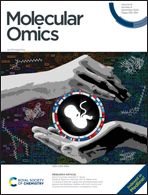Guide for protein fold change and p-value calculation for non-experts in proteomics†
Abstract
Proteomics studies generate tables with thousands of entries. A significant component of being a proteomics scientist is the ability to process these tables to identify regulated proteins. Many bioinformatics tools are freely available for the community, some of which within reach for scientists with limited or no background in programming and statistics. However, proteomics has become popular in most other biological and biomedical disciplines, resulting in more and more studies where data processing is delegated to specialists that are not lead authors of the scientific project. This creates a risk or at least a limiting factor, as the biological interpretation of a dataset is contingent of a third-party specialist transforming data without the input of the project leader. We acknowledge in advance that dedicated scripts and software have a higher level of sophistication; but we hereby claim that the approach we describe makes proteomics data processing immediately accessible to every scientist. In this paper, we describe key steps of the typical data transformation, normalization and statistics in proteomics data analysis using a simple spreadsheet. This manuscript aims to demonstrate to those who are not familiar with the math and statistics behind these workflows that a proteomics dataset can be processed, simplified and interpreted in software like Microsoft Excel. With this, we aim to reach the community of non-specialists in proteomics to find a common language and illustrate the basic steps of –omics data processing.

- This article is part of the themed collection: Emerging Investigators


 Please wait while we load your content...
Please wait while we load your content...